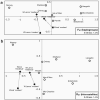Excavating past population structures by surname-based sampling: the genetic legacy of the Vikings in northwest England
- PMID: 18032405
- PMCID: PMC2628767
- DOI: 10.1093/molbev/msm255
Excavating past population structures by surname-based sampling: the genetic legacy of the Vikings in northwest England
Abstract
The genetic structures of past human populations are obscured by recent migrations and expansions and have been observed only indirectly by inference from modern samples. However, the unique link between a heritable cultural marker, the patrilineal surname, and a genetic marker, the Y chromosome, provides a means to target sets of modern individuals that might resemble populations at the time of surname establishment. As a test case, we studied samples from the Wirral Peninsula and West Lancashire, in northwest England. Place-names and archaeology show clear evidence of a past Viking presence, but heavy immigration and population growth since the industrial revolution are likely to have weakened the genetic signal of a 1,000-year-old Scandinavian contribution. Samples ascertained on the basis of 2 generations of residence were compared with independent samples based on known ancestry in the region plus the possession of a surname known from historical records to have been present there in medieval times. The Y-chromosomal haplotypes of these 2 sets of samples are significantly different, and in admixture analyses, the surname-ascertained samples show markedly greater Scandinavian ancestry proportions, supporting the idea that northwest England was once heavily populated by Scandinavian settlers. The method of historical surname-based ascertainment promises to allow investigation of the influence of migration and drift over the last few centuries in changing the population structure of Britain and will have general utility in other regions where surnames are patrilineal and suitable historical records survive.
Figures




References
-
- Adams SM, King TE, Bosch E, Jobling MA. The case of the unreliable SNP: Recurrent back-mutation of Y-chromosomal marker P25 through gene conversion. Forens. Sci. Int. 2006;159:14–20. - PubMed
-
- Bailey R, Whalley J, Bowden A, Tresise G. A miniature Viking-Age hogback from the Wirral. Antiquaries J. 2006;86:345–356.
-
- Bennett JHE, Dewhurst JC. Quarter sessions records with other records of the Justices of the Peace for the County Palatine of Chester 1559-1760 together with a few earlier miscellaneous records deposited with the Cheshire County Council. Records Soc. Lancs. Ches. 1940;94:37–39.
-
- Booth P. Calendar of Cheshire Trailbaston Proceedings 1353. Ches. History. 1983;12
-
- Bosch E, Calafell F, González-Neira A, Flaiz C, Mateu E, Scheil H-G, Huckenbeck W, Efremovska L, Mikerezi I, Xirotiris N, Grasa C, Schmidt H, Comas D. Male and female lineages in the Balkans show a homogeneous landscape over linguistic barriers, except for the isolated Aromuns. Ann. Hum. Genet. 2006;70:459–487. - PubMed
Publication types
MeSH terms
Grants and funding
LinkOut - more resources
Full Text Sources
Research Materials
Miscellaneous

